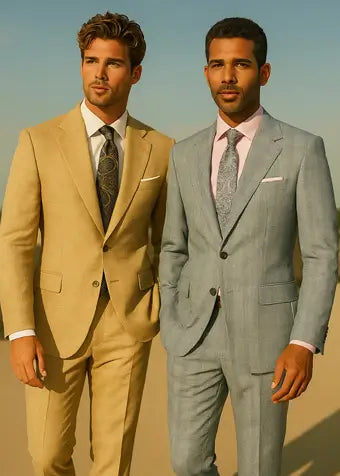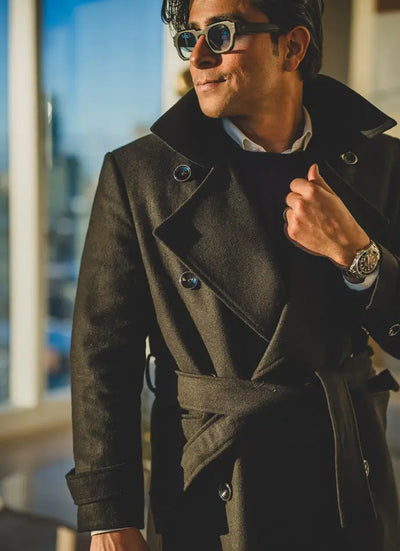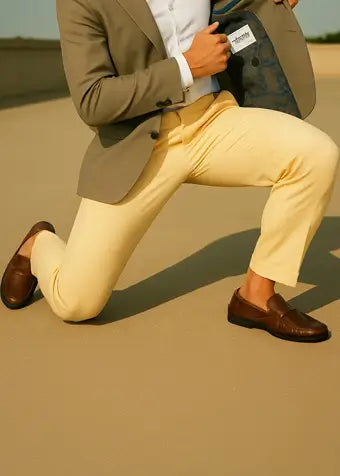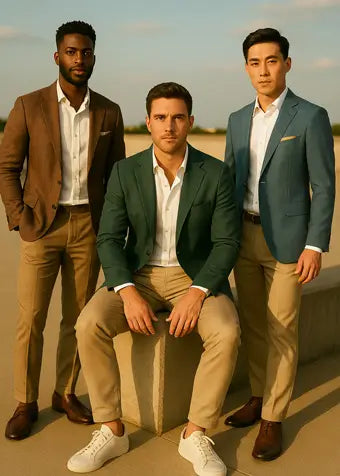Understanding Fit
Proper Lapel Width
The proper lapel depends on body size - narrow lapels are best suited for shorter & thinner men, wide lapels for larger, taller men. The lapels should lay flat against your chest without buckling.
Flattering Torso Shape
A great fit flatters your body, with as much of an hourglass shape as possible. The tapering at the waist makes your shoulders appear broader and your midsection leaner. A proper fit will feel snug against your back and upper waist.
High Arm Holes
Higher arm holes offer greater mobility and less bunching. They should feel comfortable, but in a custom suit don't expect to be able to raise your arms above your head, especially when the front button is fastened.
Comfortable Jacket Closure
A proper suit should button snugly and should fasten 1.5"-2" above your navel. Minor wrinkle lines extending outward from the button when closed are okay, but significant pulling indicates the jacket is too tight.
Backline Contour
A bespoke jacket should follow the natural arch of the backline, tapering in from the shoulder blades then back out to the rear.
Pants Fit
We recommend a flat front, slim fit style, but that's ultimately up to you. Sartoro pants taper down to the knee, leaving enough room for movement while still maintaining a snug fit.
Sleeve Length
The proper sleeve extends to just above your wrist, leaving enough room to show 1/4" - 3/4" of a proper length shirt.
Pants Break
This is a matter of preference, but we recommend a length that covers the tops of your shoes with no or at most a partial break in the fabric. The pants should not bunch. We recommend no cuffs for a modern look.
Collar
The back of the jacket should sit smoothly against your upper back, allowing 1/2"-3/4" of the shirt collar to be visible above the jacket.
Jacket Length
This is a matter of preference, but modern style favors a shorter length that should finish between midway and just above the base of your rear. The final length depends on the cut of the suit (slim, modern or classic).
Shoulders
The jacket should lay flat across the shoulder blades, extending to the edge of your natural shoulders. If lines across the middle of the back or billowing occurs, the shoulders are not sized properly.
Vents
With the exception of certain tuxedos, a jacket should always have vents. Single vents offer a casual look while double vents provide a more formal, bespoke appearance.
Proper Lapel Width
The proper lapel depends on body size - narrow lapels are best suited for shorter & thinner men, wide lapels for larger, taller men. The lapels should lay flat against your chest without buckling.
Flattering Torso Shape
A great fit flatters your body, with as much of an hourglass shape as possible. The tapering at the waist makes your shoulders appear broader and your midsection leaner.
High Arm Holes
Higher arm holes offer greater mobility and less bunching. They should feel comfortable with enough breathing room to move around freely.
Comfortable Jacket Closure
A proper suit should button snugly but without pulling and should fasten 1.5"-2" above your navel. If there are wrinkle lines extending outward from the button when closed, the jacket is too tight.
- Lapel
- Torso
- Arm Holes
- Closure
The proper lapel depends on body size - narrow lapels are best suited for shorter & thinner men, wide lapels for larger, taller men. The lapels should lay flat against your chest without buckling.
A great fit flatters your body, with as much of an hourglass shape as possible. The tapering at the waist makes your shoulders appear broader and your midsection leaner. A proper fit will feel snug against your back & upper waist.
Higher arm holes offer greater mobility and less bunching. They should feel comfortable, but in a custom suit don't expect to be able to raise your arms above your head, especially when the front button is fastened.
A proper suit should button snugly and should fasten 1.5"-2" above your navel. Minor wrinkle lines extending outward from the button when closed are okay, but significant pulling indicates the jacket is too tight.
- Backline
- Sleeves
- Pants
- Break
A bespoke jacket should follow the natural arch of the backline, tapering in from the shoulder blades then back out to the rear.
The proper sleeve extends to just above your wrist, leaving enough room to show 1/4" - 3/4" of a proper length shirt.
We recommend a flat front, slim fit style, but that's ultimately up to you. Sartoro pants taper down to the knee, leaving enough room for movement while still maintaining a snug fit.
This is a matter of preference, but we recommend a length that covers the tops of your shoes with no or at most a partial break in the fabric. The pants should not bunch. We recommend no cuffs for a modern look.
- Collar
- Shoulders
- Vents
- Length
The back of the jacket should sit smoothly against your upper back, allowing 1/2"-3/4" of the shirt collar to be visible above the jacket.
The jacket should lay flat across the shoulder blades, extending to the edge of your natural shoulders. If lines across the middle of the back or billowing occurs, the shoulders are not sized properly.
With the exception of certain tuxedos, a jacket should always have vents. Single vents offer a casual look while double vents provide a more formal, bespoke appearance.
This is a matter of preference, but modern style favors a shorter length that should finish between midway and just above the base of your rear. The final length depends on the cut of the suit (slim, modern or classic).
The Sartoro Digital Tailor Fit
Our Digital Tailor uses an advanced algorithm to predict body measurements to within 3% of exact sizes. Master tailors measure to within 2% accuracy, so use of the Digital Tailor results in a near if not perfect fit.
If you opt for self measurement, your numbers are still run through the Digital Tailor, allowing our team to flag any measurements that might be incorrect.
The Sartoro Digital Tailor Fit
Our Digital Tailor uses an advanced algorithm to predict body measurements to within 3% of exact sizes. Master tailors measure to within 2% accuracy, so use of the Digital Tailor results in a near if not perfect fit.
If you opt for self measurement, your numbers are still run through the Digital Tailor, allowing our team to flag any measurements that might be incorrect.




























